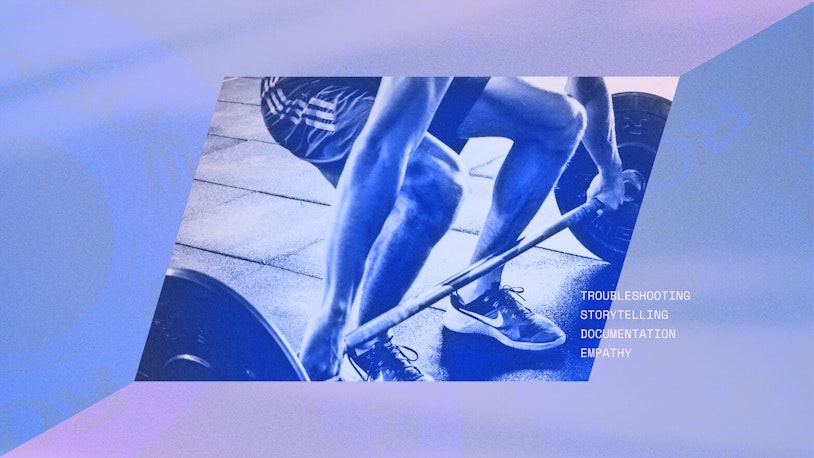AI and the future of support teams, three truly terrible predictions, some action items for support leaders, and Shawna explains the Rule of 40. I'm Mat Patterson. This is The Supportive.
A new customer support podcast right as AI is replacing us all. Really? I’m like a middle aged dinosaur taking up jogging because that weird new light in the sky seems like a good omen.
Is this all just a waste of time? Should we all go listen to the latest true crime podcast about the mysterious disappearance of normal shaped jeans?
No. No. There is still plenty of life left in customer support as an industry and as a career. If you care about creating good customer experiences, then right now is the time to pay attention because things are about to get a bit weird.
That uncertainty about the future sort of new in the support world because the way we built support teams really didn't change a lot between about 1980 and 2020.
Here's how it used to go down. Founders would start off using their shared Gmail inbox to do support until that got a bit messy, then they get tired of people not reading the FAQs. They'd hire a first support person. That person would hire some more people. They'd all create better documentation, maybe add some support channels, they'd start creating support tiers.
And sure, there was some variation for But if But if you wanna start an online support team today, well, then that model's looking a little bit dusty like the Tamiya F14 that's still hanging from the ceiling of my old bedroom.
Why? Because generative AI and large language models will change the way we structure support departments and how we staff them.
If you're a customer centric leader or you plan to be one, what do you do about that? What specifically is going to change? What should we do differently?
Well, I can't see the future. I mean, if I could, I would never have bought that pizza with Bitcoin, would I? Still, I do want to give you some predictions, but before I do that, let me quickly lower those expectations with these three terrible predictions from history.
#3. In 1959, the US postmaster general predicts mail will soon be delivered from New York to Australia by guided missiles.
#2. In 1966, John Fisher predicted that automation would mean we ran out of work for people to do and therefore moonlighting with a second job would soon be as socially unacceptable as bigamy. “The all new Wife Swap.”
#1. Microsoft's Steve Ballmer predicted zero chance that the iPhone gained any significant market share. I tried to call him to verify that quote, but turns out my Windows phone hasn't worked since 2017.
Now with that nice low bar for predictions to beat, what can we predict about the effect of AI on the way we build support teams from this year on?
Well, here's the short answer. AI will be part of every decision. Whatever decisions you make as a leader, how many people to hire, how to set up reporting, which channels to support, how you manage your queue, there will be an AI angle to all of them. And the decision makers above you will want your opinions on all of that. And whether or not you see your role for AI in any particular area, you will need to have thought it through and have an informed perspective to share with them. So I'm gonna give you four broad predictions.
Prediction #1
Self-service will be central. This is the big change. More customers getting helped without having to talk to a person might be because they chatted with a bot, might be because they were sent to the right help doc automatically, or an automation answered their email before a human needed to. And the basic financial calculation of all support teams is how many people do we need to serve a given number of customers.
An AI really might be able to shift that ratio by helping more people without needing more staff. But that only works if the self-service experience is at least acceptable, and often today, it's not, let alone with these unproven AI tools. So it's the teams who really nail that self-service interaction, who figure out how to make it work, and where to pop people out of a self-service process and into a human interaction.
Those are the teams who will win in the long term.
Prediction #2
Lower cost per interaction means new support models. If we do see that shift of a big chunk of support requests going into AI based self-service, that will mean some money saved. How much money?
Well, that's not clear yet. The big AI models, they're all still fighting over owning the market. Whoever wins, the end user pricing will change. But we know it's going to cost more than the customer just serving themselves with the knowledge base with no AI, and it will probably cost less than the hourly cost of a support team. How much less? Well, that's really going to depend on how the tools are implemented, how they’re used. So why does that matter?
Lower cost per interaction that means you've got different scaling options. If your staff can now answer fewer of the basic questions they've got some time left over, what do they spend that time on? What valuable service could you offer to customers that now might fit into your time and money budget?
Stop thinking about it now. Otherwise, all that lovely saved money, it'll just disappear into the budget of Brad from sales.
Brad.
Prediction #3
Customer support QA will be transformed.
But when someone on your team now makes a mistake, you can hold them accountable, but you can also support them. You can identify what went wrong. You can help them correct it, and they can feel bad about it, and they can want to do better. AI cannot feel bad despite chat GPT's obsession with apologizing to me for not being able to do anything.
AI doesn't actually understand anything, and it can't be taught in the same way as a person. It'll make things up without any compunction.
These are all solvable problems or at least they're addressable problems, But maintaining that high quality of service when you're using AI, that will need a different approach than the one we're using today.
We'll need people who understand how the AI is being trained, how the model can be tweaked, how we're going to monitor the output of AI.
These will be new specialist skills and roles coming into customer support.
Prediction #4
Support will be built on flexibility.
And if you think when I say flexibility of the foul stench of gig economy contract worker abuse...well sniffed. I mean, that's definitely how that word is often used today, but I think there's a more positive alternative here. In a research study, AI enhanced onboarding for new support agents got people up to speed much more quickly than the old ways did.
Those AI suggestions can really cut down a lot of the figuring out where to even look for the answer time, and that might mean it's now more feasible to move people in and out of queues as needed. This is actually a success secret for Costco and some other retailers cross training staff on different jobs so if there's a gap to cover, if there's a surge of customers or a surge of problems in a particular area, they can shift people around more easily.
And in tech support, historically, that's been a lot harder to do because of the wider range of specialized knowledge that people need to operate in those different areas. But with AI help, we might see that skilled support people now can shift around internally to different products or different areas more often and more easily.
Scaling up and down with the help of outsourcing teams like Boldr or Partner Hero might become more practical for smaller teams than it is today.
So those are my four predictions on how AI will change the structure of support teams. Self-service will be central, lower cost per interaction, transformation of QA, more flexibility. So what? What do we do about that?
How do we prepare our teams for those changes? How do we run our teams differently?What pieces should we start moving now? Well, before we get into that, let's just briefly visit with Shawna Fisher, my favorite Chief Financial Officer, although to be fair, in a not hugely competitive field.
Now I have an IT degree, but that's not a business education. So when I started in a support leadership role, I really didn't know a lot about the mechanics of how businesses work, what all the acronyms meant, and more importantly, why they mattered to the business and why they should matter to me. And I suspect a lot of you listening probably have similar challenges. So I've asked Help Scout CFO, Shawna, if she will give me some quick classes in remedial business metrics, and I'm gonna include one of those lessons in each podcast. And that way, you can learn too, and then we can all pretend that we always knew it next time we're in one of those meetings.
[ Coming soon: Shawna Explains: The Rule of 40 on the Help Scout blog ]
Thank you, Shawna. Alright. Let's get back to how AI is changing the structure of support teams. What can you do as a support leader that will help your team make it through this AI upheaval and keep delivering great service? I'm just going to give you three action items because I know you love a listicle even though you pretend that you only read the serious long articles. I mean, in the same way that I know which Hogwarts house your cat would be in (Slytherin).
Action item #1
Decide again what good service looks like for your team. AI is a method. It's not a feature. It's a way of delivering the type of customer experience that you want to deliver.
So you need to know what that experience is. If you don't, you'll end up just delivering whatever mediocre default the AI gravitates towards.
So sit down with your teams, spend some time deciding on which customer experiences you want to create. How should it feel to be a customer of your business and to have a service interaction with you?
Write it down and make it something that you can measure against so you know if you're doing it.
Action item #2
Stay informed about AI, the tools, and the capabilities.And look, if you're not super into tech for tech's sake, I understand it can be absolutely overwhelming to keep up with the change. But you do need to know what can be done with AI and what can't. If you don't, other people will decide for you how AI is going to affect your team and your customers. Look, there are smart, informed, empathetic people out there to follow in the field of AI and we're going to put together a list of them for you soon, but here are two names you can start with, Ethan Mollick and Genevieve Bell, and I'll put some information about them in the notes.
Action item #3
Identify and prioritize key AI opportunities. Where are the spots in your service processes and customer interactions that AI could add the most value?
You need to know the answer to this question. Some of your competitors will figure it out for themselves. Other people in your business will want the answer too.
Maybe it's in tagging and reporting to understand your customers better. Maybe it's helping people find the right knowledge base articles. Maybe it's onboarding new team members. Maybe it's scaling up your QA.
Sit down, make a list, put it in order, and then keep your eyes open for possible solutions. Alright. So your takeaways today, you're gonna define good service for your team, you'll keep up with AI news, you'll make a list of where you can best use it. That's enough to be getting on with, I think.
In the show notes, you will find all of those items listed, you'll find the transcript, my article on this topic, and a place to share your comments or questions and I would love to hear from you. But let me leave you with this thought, AI change is coming and you don't want to be the last of the dinosaurs.
You want to be the first of the mammals creeping out into a new world as the dust starts to settle.
I'm Mat Patterson. This has been The Supportive.







